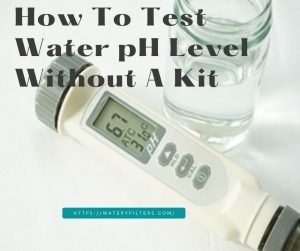Table of Contents

Pure water falls at the 7 on the scale as it is in between the levels of acidic and alkaline levels. pH is an important indicator to test the acidity levels in water so that is considered suitable for drinking.
But what happens if you find yourself in a position where you don’t have the special pH kit to test the water? It could be due to a number of reasons, maybe you are at a place where a kit is not available or maybe the pH kit is too expensive or maybe, you need it instantly and don’t have time to wait around for your product to be delivered.
Though having a pH kit is considered an ideal handy solution to test water’s acidity, don’t worry if you don’t have it for some reason, this guide will offer some easy solutions to test water pH level without a kit at the ease of your own home.
How To Test Water pH Level Without A Kit
Here’s a video guide to test water pH level without a kit:
The following image shows the neutrality of water on a 0 to 14 point scale.
Here are some other ways to test the water pH level without a kit:
Cabbage method
The most commonly found method that you can easily utilise in the comfort of your home is the red cabbage method. The method is simple: just cut down the red cabbage into pieces and place it in a big bowl, then fill it with distilled water (A form of purified water) in this case you will add two cups that have been pre-boiled. Be sure that the cabbage is entirely immersed with the water you poured and then leave it for about 30 minutes.
While you left the water with the cabbage, a reaction took place and the colour of the water should have been changed by now. Strain the cabbage and put the altered water solution in a separate container. There you have it, your very own pH indicator solution. Now all you have to do is get the sample of the water you want to test and add a few drops of this DIY pH solution you made and you will see it work its way. For the neutral effect, the water will change into purple colour, for acid it will go red and for alkaline it will turn into a bluish or green colour.
Litmus method
This is the most affordable option that will definitely provide accurate results and you can get them from possibly anywhere. It is actually cheaper than investing in a proper pH kit because the pH kit tends to be used only once while the litmus paper can be accessed anywhere and for any time you want to use it.
Again, proceed to get your water sample for testing in a container and dip the litmus paper in it. Take it out and see the colour change: for alkaline you will see a blue tint, for acidic it will turn red and it will stay the same colour if the water is perfectly neutral, which is at point 7.
Digital method
This option is an optional one, as it is a bit costly but definitely a more accurate one especially if you have to test a large sample of water body. If you are okay with spending a bit of money for your pool or well, then getting the digital pH tester is the best option. It will identify the correct pH level of water that is also considered neutral by many water filters you would have installed at home. If the water falls lower on the pH scale, it means it has more chances of being dangerous for you.
Strip method
This is a fun part, you can use the cabbage solution as a pH indicator by using some homemade strips. You can either use the coffee filters or there are some acid-free art paper strips present in the market or a local store in your area.
The process of testing is to dip your DIY strips in the cabbage solution you made earlier and then cut them into smaller pieces about an inch in size. Then get the sample testing water either in a container such as a glass of water or you can use a pipette to drop the water sample drops on the DIY strips. Once you dip or drop water on the strip, put it aside and let it dry to see the alteration in colour. Once the colour appears you can compare it to the pH colour chart to determine the pH level of water.
Don’t forget to use the homemade strips within a specific time period (less than a week) as they will expire and will not be usable.
FAQS
What other fruits or vegetables can be used instead of cabbage?
You can either use blueberries, rose petals or even red onions to create your very own pH indicator solution at home.
Why should I test the pH level of water?
If you feel like your water has been feeling different or harsh or even tasting weird, then it’s time to test the water to ensure it is neutral.
How do I know the homemade pH indicator solution is accurate?
If you feel like your DIY pH indicator solution is far from accurate then try testing it on acids and alkaline solutions such as baking soda and vinegar instead of water, this way you will know the solution is working.
